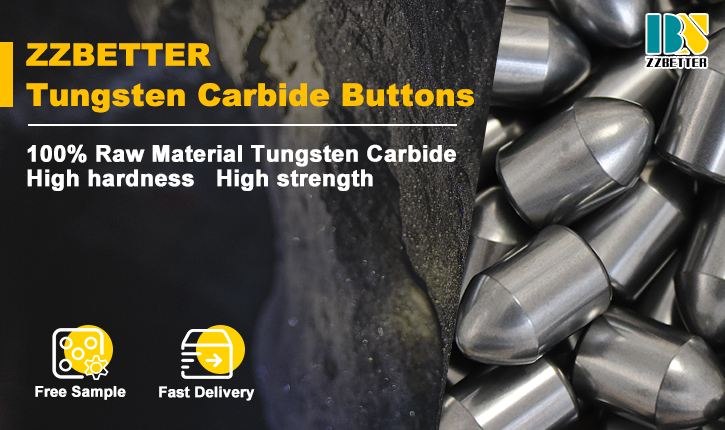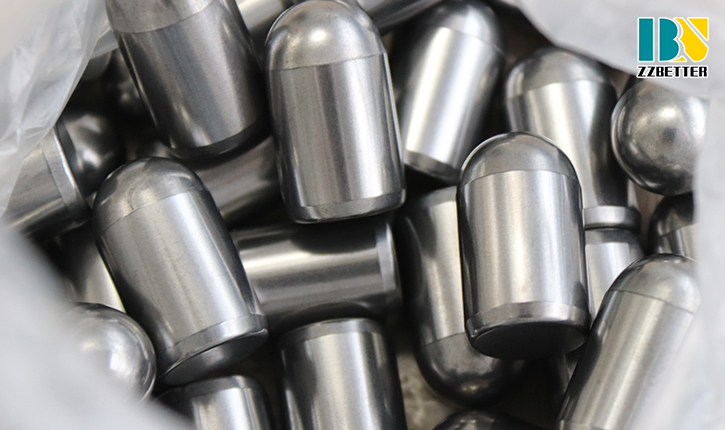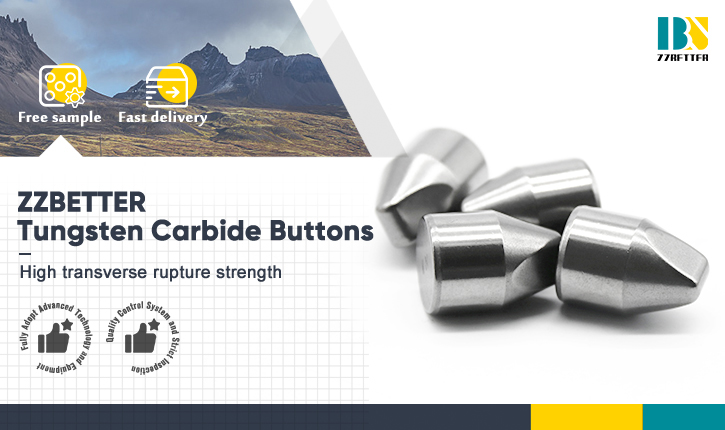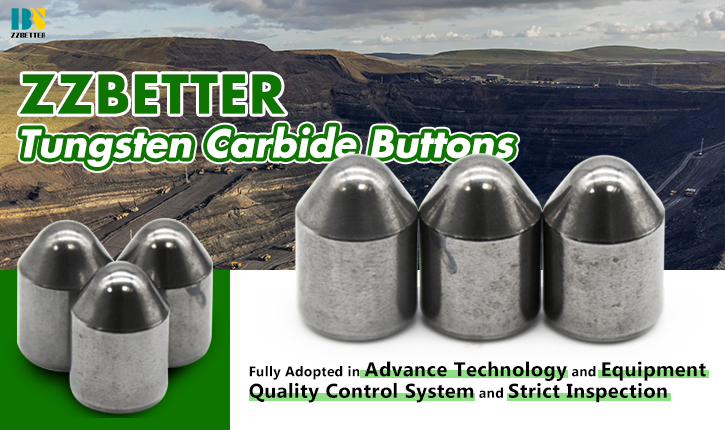7 Failure Modes of Tungsten Carbide Buttons
7 Failure Modes of Tungsten Carbide Buttons

As a tungsten carbide buttons manufacturer, we found many customers suffering the questions about tungsten carbide failure. These questions can be abrasive wear, thermal fatigue, spalling, internal cracks, fracture of non-exposed parts of the carbide button, shear fracture, and surface cracks. To solve these problems, we should figure out what these failure modes are, and observe the place where the carbide buttons are most damaged and wear often happens, the carbide buttons fracture surface. In this article, we are going to talk about these 7 failure modes and the suggestions to solve them.
1. Abrasive wear
What is abrasive wear?
Abrasive wear happens during the collision and friction between the tungsten carbide buttons and rocks. This is a normal and inevitable failure mode, which is also the final failure mode of the drill bits. Generally speaking, the wears of the central buttons and the gauge buttons are different. The carbide buttons, which are closer to the edge, or the ones with higher linear speed during work, will have greater relative frictions with the rock, and the wear can be more serious.
Suggestions
When there is only abrasive wear, we can appropriately improve the wear resistance of tungsten carbide buttons. We can reduce the cobalt content amount or refine the WC grains to achieve the goal. What we should notice is that the wear resistance of the gauge buttons must be higher than that of the central buttons. Increased stiffness can be counterproductive if other failure possibilities exist.

2. Thermal fatigue
What is thermal fatigue?
Thermal fatigue is caused by the high temperature due to the impact and friction between the tungsten carbide mining tips, which can be as high as about 700°C. It can be observed from the appearance of the tungsten carbide buttons when there are intersecting semi-stable cracks on the surface of the button teeth. Severe thermal fatigue will completely damage the cemented carbide buttons and make the drill bit worn.
Suggestions
1. We can reduce the cobalt content in the alloy to decrease the thermal expansion coefficient of the tungsten carbide buttons;
2. We can increase the grain size of the tungsten carbide powder to increase the thermal conductivity so that the high temperature caused during friction can be released in time;
3. We can apply the non-uniform structure of the WC grain to ensure a reasonable thermal fatigue resistance, wear resistance, and toughness;
4. We can redesign the drill bits to reduce the exposed area of the button;
3. Spalling
What is spalling?
Spalling is a term used to describe areas of concrete that have cracked and delaminated from the substrate. In cemented carbide industry, it refers to a failure mode. The contact surface between the cemented carbide buttons and the rock is under uneven force, and cracks are formed under the repeated action of these forces. The toughness of the alloy is too low to prevent the crack from expanding, resulting in the spalling of tungsten carbide buttons.
For those cemented carbide buttons with higher hardness and lower toughness, obvious spalling occurs, which will greatly shorten the life of the drill bit. The spalling size of the tungsten carbide buttons is related to the composition of the alloy, the grain size of WC, and the mean free path of the cobalt phase.
Suggestions
The key to this issue is how to increase the toughness of the cemented carbide buttons. In manufacturing, we can improve the toughness of cemented carbide buttons by increasing the cobalt content of the alloy and refining the WC grains.

4. Internal cracks
What are internal cracks?
Internal cracks are the cracks from the internal structure of tungsten carbide buttons, which is also known as an early fatal failure. There are smooth parts, which are also called mirror parts, and rough parts, which are also called jaggies parts, on the fracture surface. The crack source can be found in the mirror part.
Suggestions
As the internal cracks are mainly caused by the cemented carbide buttons themselves, the method to avoid internal cracks is to improve the quality of the tungsten carbide buttons themselves. We can adapt pressure sintering, and hot isostatic pressing with heat treatment after sintering.
5. Fracture of non-exposed parts
What is a fracture of non-exposed parts?
When we forged tungsten carbide buttons in an improper way, the fracture of non-exposed parts will occur. And it can also be caused by the large tensile stress from the out-of-round shape of the fixed gear hole and the ball tooth causing the stress to concentrate on a certain point on the button body. For cracks that occur where the hole is shallow, the cracks will slowly spread with a little bending, and finally, form a smooth surface. For cracks that originate in the deep part of the drill bits hole, the crack will cause the upper part of the button to split longitudinally.
Suggestions
1. Ensure the smoothness of the ball teeth after grinding, no out of round, no grinding cracks;
2. the bottom of the tooth hole must have a proper support shape that conforms to the bottom surface of the button;
3. choose the appropriate tooth diameter and hole diameter when cold pressing or hot embedding The matching amount.

6. Shear fracture
What is a shear fracture?
A shear fracture refers to the breakage and/or disintegration of a material due to the application of a strain force on its surface. The shear fracture of tungsten carbide is the result of tungsten carbide buttons being constantly exposed to compressive and shear stresses above the limits the tungsten carbide can withstand. Generally, the shear fracture is not easy to be found out, and can still work on after the fracture exists. Shear fracture is more commonly to be seen at the tip of the chisel.
Suggestions
To reduce the possibility of shear fracture, we can round the cemented carbide buttons, and design and select the appropriate drill bit structure.
7. Surface cracks
What are surface cracks?
Surface cracks are generated after high-frequency load and other failure mechanisms. The small cracks on the surface will enlarge intermittently. It is caused by the structural form, the drilling method of the drill bits, the position of the tungsten carbide button teeth, and the structure of the rock to be drilled.
Suggestions
We can reduce the content of cobalt on the surface to increase the hardness and improve the toughness of the tungsten carbide mining buttons.

Following the failure modes and suggestions, you may further understand why your tungsten carbide buttons fail at work. Sometimes, you may also find that is difficult to figure out what is the main issue about your tungsten carbide buttons, even though you are familiar with every type of failure mode because there is not only one causes making sense.
As a tungsten carbide button manufacturer, how to solve customers’ issues about tungsten carbide wear is our response. We will analyze the cases, find out the problem, and give our customers a better solution.





















